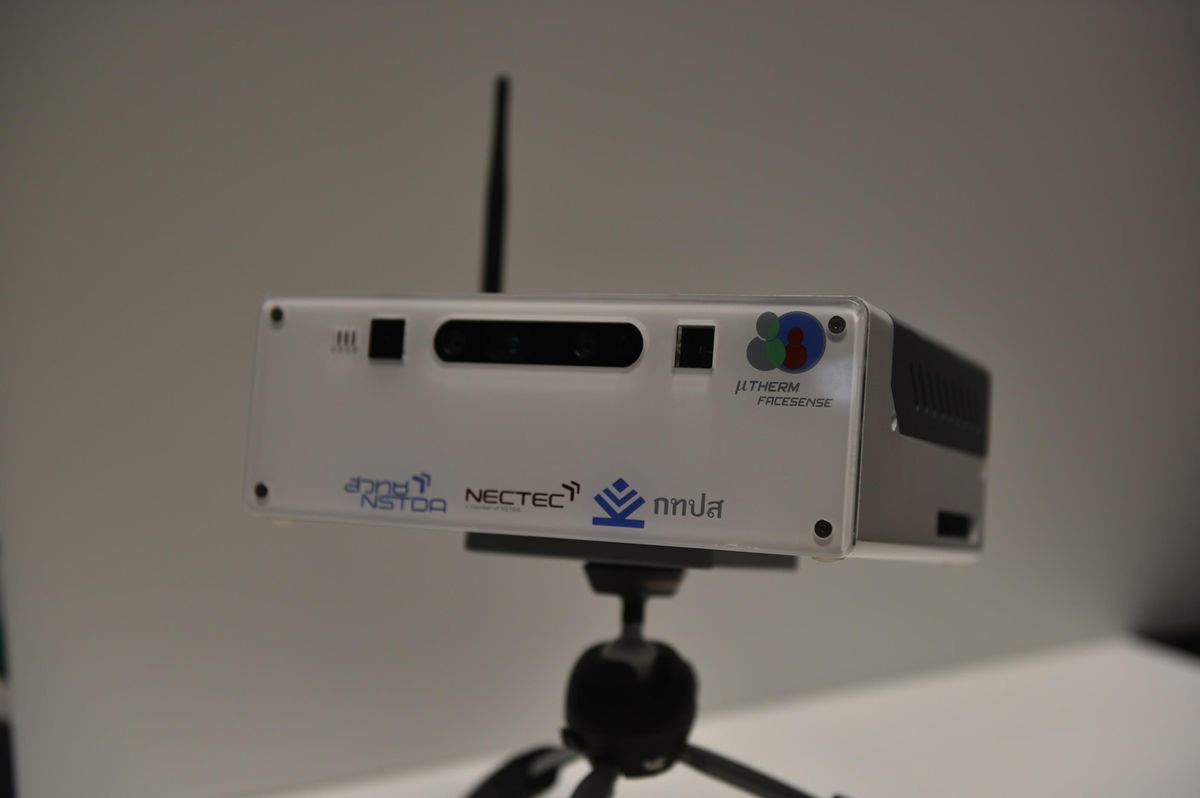THE INSTITUTE A team of researchers at Thailand's National Electronics and Computer Technology Center, part of the country's National Science and Technology Development Agency, in Pathumthani, has built a temperature-screening system called µTherm-FaceSense (m reads as mu) that can examine up to nine people at a time. Fever is a common symptom of COVID-19. More places are screening people so the ability to scan several at once could eliminate waiting lines, the researchers say. By the end of July, nearly 40 of the units will be installed in several of the country's hospitals, correctional facilities, and public transportation systems.
The project is being led by Armote Somboonkaew, Sirajit Vuttivong, Chalee Vorakulpipat, and Sarun Sumriddetchkajorn, an IEEE senior member. The mTherm-FaceSense, or MTFS system, combines a visible camera and a thermal imaging camera. It is equipped with features such as Lidar and facial recognition—which can be used with or without a facial covering—to determine where a person is standing in the camera's field of view.
MTFS also uses an algorithm that compensates for distance shift that happens with traditional thermal-imaging-based temperature scanners. Distance shift occurs when several individuals being checked are not at the same measuring distance, leading to a fluctuation in temperature measurements. Measurements from the Lidar and other inputs are used to compensate for variations in distance between an individual and the scanner.
The Institute asked Sumriddetchkajorn about how MuTherm-FaceSense works.
This interview has been edited and condensed for clarity.
What problems are you trying to solve?
We are trying to find ways to compensate for distance shift and the surrounding temperature fluctuation [that happens] during temperature screening. As we measure the facial temperature, we also look for a way to correctly analyze facial temperature values from people with and without their facial masks on.
Explain how the MuTherm-FaceSense works.
It basically looks for all faces in its field of view, and then simultaneously analyzes the corresponding facial temperatures [of each]. If the temperature of any person detected is equal to or above the threshold value, for example, 37.5°C, his or her temperature value is highlighted in red on a display screen and a beep sounds. If the person has no fever, the temperature value is shown in green and there is no beep.
Again, fluctuations from the distance shift and the surrounding temperature are compensated [for] during the temperature screening.
The set-up process is simple and is similar to a typical thermal imaging camera that is used for fever screening today.
What challenges have you faced, and how did you overcome them?
The accuracy of the measurement [in the prototype] was not acceptable and not stable due to the distance shift and the fluctuation of [the] surrounding temperature. Once we brought in Lidar and designed and implemented our own low-cost internal reference temperature, these issues improved tremendously.
We also designed and engineered the prototype so that it passes electrical safety requirements and has no spurious signals that can disturb other electrical appliances or medical equipment. It complies with IEC60950-1, the international standard related to electrical safety requirement and CISPR22, the international standard related to electromagnetic compatibilities.
What is the potential impact of the system?
MTFS benefits society as a whole for the public's health during and after COVID-19. Because it was invented in Thailand, we also believe that once the technology transfer to a private company happens, it will create more jobs in the country and improve the skills and knowledge of the talented workers. It has the potential to be a high-tech export product of Thailand as well.
Where has the system been installed?
Units have been installed at various facilities in Thailand including the National Science and Technology Development Agency, the Office of the National Broadcasting and Telecommunications Commission, and the Thai Red Cross Society. In addition, they can be found at medical facilities including the King Chulalongkorn Memorial Hospital, the National Cancer Institute, Phra Nakhon Sri Ayutthaya Hospital, and Phramongkutklao Hospital.
MuTherm-FaceSense is also being used at prison and correctional facilities in Bangkok, Pattaya, and Phuket. Train stations that are part of the State Railway of Thailand are also using the devices.
How many people are on the team?
Fifteen people are involved in the research and development.
IEEE membership offers a wide range of benefits and opportunities for those who share a common interest in technology. If you are not already a member, consider joining IEEE and becoming part of a worldwide network of more than 460,000 students and professionals.


